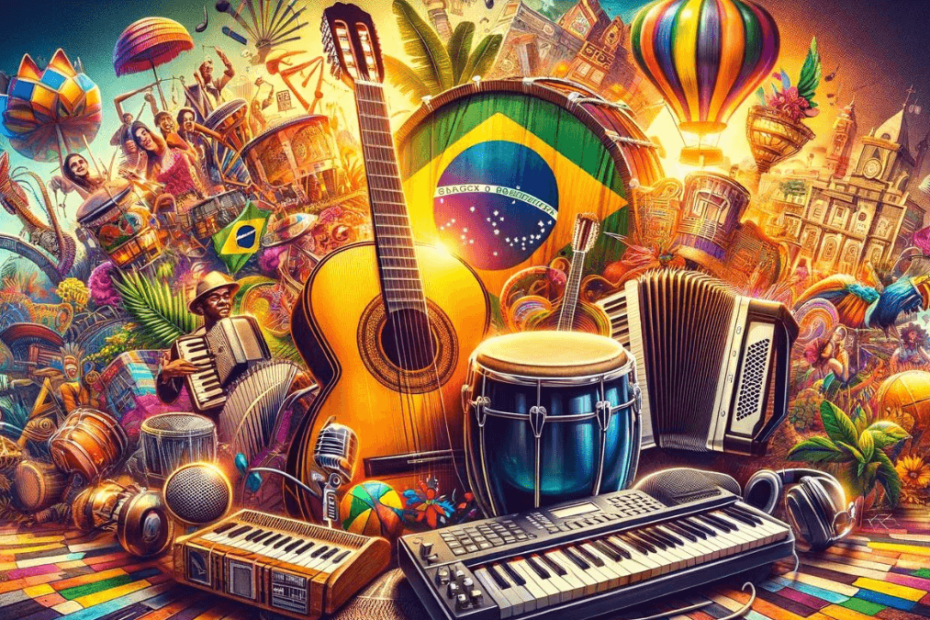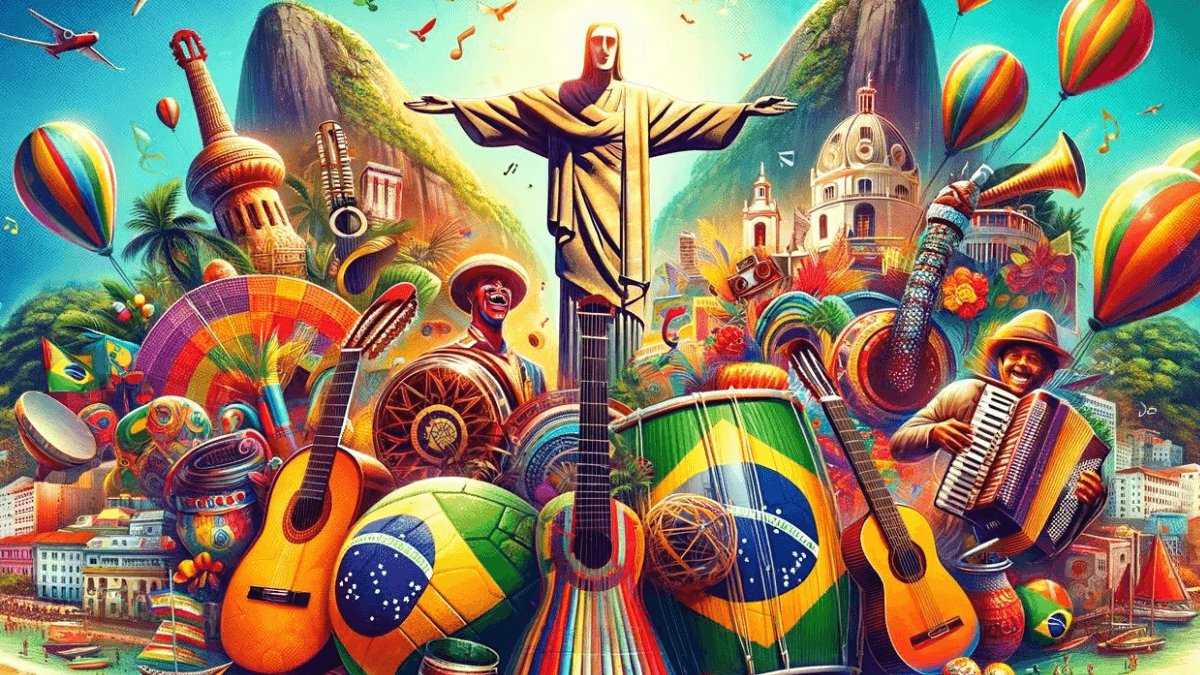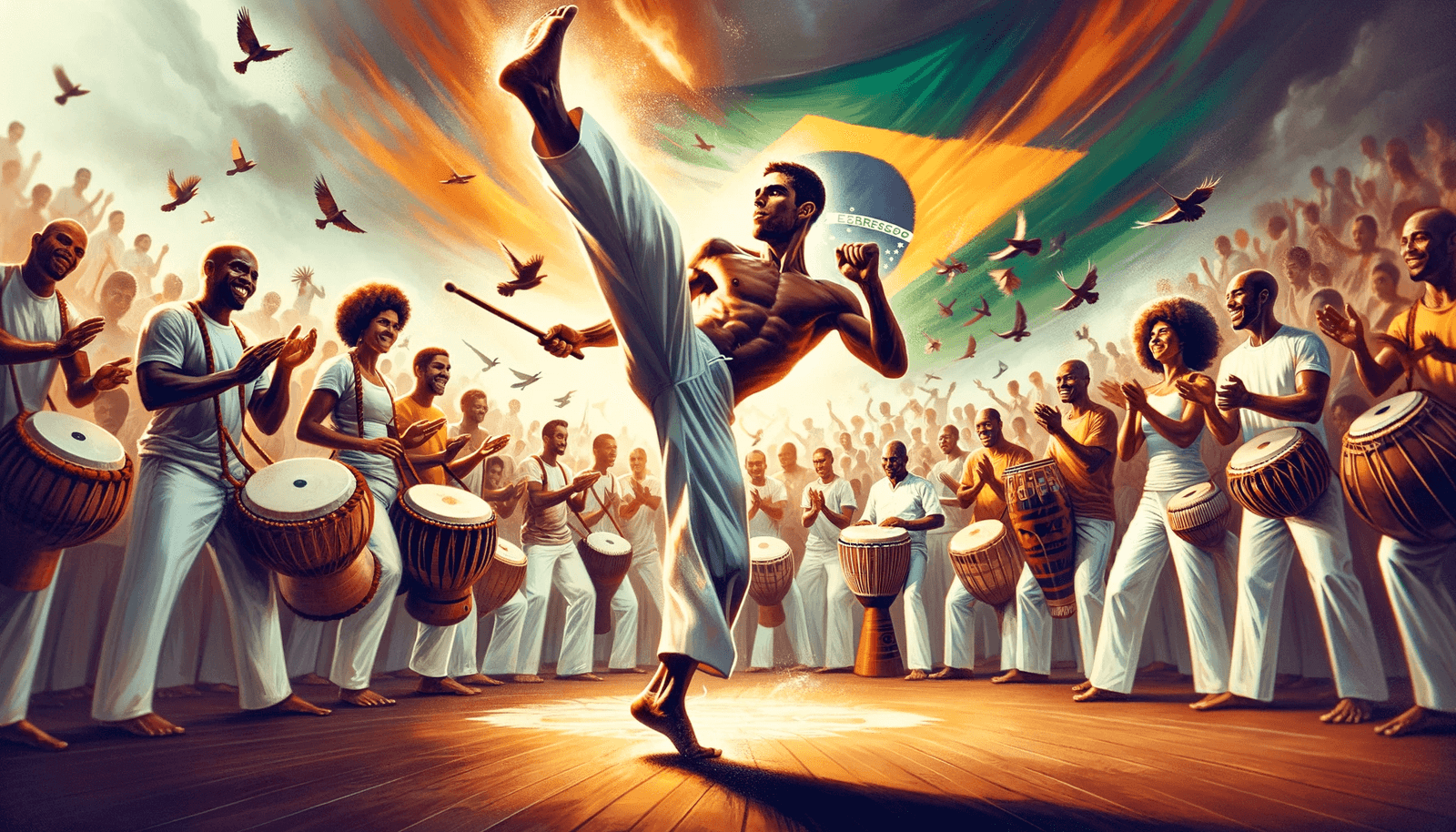Dive into Brazilian music genres, a vibrant reflection of the country’s soul.
Key Takeaways:
- Brazilian music genres are diverse, reflecting the country’s rich cultural tapestry.
- From Samba to Bossa Nova, each genre tells a unique story of Brazil.
- Explore the traditional to modern sounds that define Brazil’s musical identity.
As a Brazilian deeply passionate about our rich musical heritage, I’m thrilled to guide you through the diverse and vibrant spectrum of genres that define our cultural identity.
From the rhythmic beats of Samba that pulse through Rio’s Carnival to the soulful melodies of MPB that narrate our stories, each genre is a testament to our resilience, joy, and unparalleled creativity.
Join me as we explore the traditional sounds of Forró, the innovative rhythms of Tecnobrega, and the global charm of Bossa Nova.
This journey is more than just an exploration of music; it’s an invitation to feel the heartbeat of Brazil, to understand its soul, and to celebrate the diversity that makes us unique!
Brazilian Music Genres: the 23 most popular
Embark on a melodious journey as we explore the 23 most popular Brazilian music genres, delving into the heart and soul of Brazil’s rich musical heritage.
Arrocha
What It Is: A romantic and danceable genre blending Sertanejo’s sentimental melodies with rhythmic influences from Axé.
Influences: Primarily influenced by Sertanejo and Axé, with roots in Bahia’s diverse cultural mix.
Region: Most popular in the Northeast, particularly in Bahia.
Main Artists: Pablo (“The Voice of Arrocha”), Tayrone.
Notable Songs: “Porque Homem não Chora” (Pablo), “Dez Dias” (Tayrone).
Axé
What It Is: A vibrant, high-energy music genre that combines Afro-Brazilian rhythms, reggae, rock, and pop. It emerged in the 1980s in Salvador, Bahia, becoming synonymous with Brazil’s Carnival.
Influences: Draws from Afro-Brazilian traditions, samba-reggae, frevo, and more, reflecting the cultural melting pot of Bahia.
Region: Salvador, Bahia, is the epicenter, but it’s popular nationwide, especially during Carnival season.
Main Artists: Ivete Sangalo, Daniela Mercury, and Claudia Leitte are among the most iconic Axé singers, known for their dynamic performances.
Notable Songs: “Festa” (Ivete Sangalo), “O Canto da Cidade” (Daniela Mercury), “Largadinho” (Claudia Leitte). These tracks capture the essence of Carnival and are guaranteed to get listeners dancing.
Baião
What It Is: A rhythmical genre originating from the Northeast of Brazil, characterized by its fast tempo and syncopated beats. It’s one of the main components of Forró music.
Influences: Draws heavily from indigenous, African, and European (particularly Portuguese) musical traditions, reflecting the diverse cultural heritage of the Northeastern region.
Region: Most popular in the Northeast, especially in states like Pernambuco, Ceará, and Paraíba.
Main Artists: Luiz Gonzaga, known as the “King of Baião,” and Dominguinhos are pivotal figures in popularizing Baião.
Notable Songs: “Asa Branca” (Luiz Gonzaga), “Isso Aqui Tá Bom Demais” (Dominguinhos). These songs not only showcase the Baião rhythm but also tell stories of life in the Northeast, its challenges, and its beauty.
Bossa Nova
What It Is: A soft, lyrical fusion of samba and jazz that emerged in the late 1950s, known for its smooth melodies and sophisticated harmonies.
Influences: Combines the rhythmic complexity of Samba with the harmonic richness of Jazz, influenced by West Coast jazz musicians and Brazilian samba artists.
Region: While it originated in Rio de Janeiro, Bossa Nova gained international fame and is enjoyed worldwide.
Main Artists: João Gilberto, Antônio Carlos Jobim, and Vinícius de Moraes are foundational figures, known for their groundbreaking work in the genre.
Notable Songs: “The Girl from Ipanema” (Antônio Carlos Jobim and Vinícius de Moraes, famously performed by Astrud Gilberto and Stan Getz), “Chega de Saudade” (João Gilberto). These songs epitomize the cool, breezy essence of Bossa Nova, capturing the heart of Rio’s beach culture in the ’60s.
Plan your trip to Brazil
- Find the cheapest flights
- Discover the best accommodation
- Explore this incredible country with the best experiences
- Stay connected at all times with an eSIM
Brazilian Pop
What It Is: A broad genre that encompasses a variety of contemporary rhythms and styles, integrating traditional Brazilian sounds with global pop music trends.
Influences: Draws from local genres like Samba, Bossa Nova, and Axé, while also incorporating elements of rock, hip-hop, and electronic music from around the world.
Region: Popular nationwide, reflecting the diverse musical tastes of Brazil’s urban centers.
Main Artists: Anitta, Ludmilla, and Luan Santana are prominent figures who have successfully blended Brazilian rhythms with international pop appeal.
Notable Songs: “Vai Malandra” (Anitta), “Cheguei” (Ludmilla), “Te Esperando” (Luan Santana). These hits showcase the versatility and global appeal of Brazilian Pop, making waves both domestically and internationally.
Brazilian Rap
What It Is: A powerful medium for social commentary and expression, Brazilian Rap emerged in the late 1980s and early 1990s, offering a voice to the marginalized communities within the urban centers of Brazil.
Influences: Draws from the global hip-hop movement, infusing local Brazilian cultural, social, and political themes. Its beats and rhymes address issues like poverty, racial discrimination, and inequality.
Region: Predominantly heard in São Paulo and Rio de Janeiro, but its influence and popularity span across the country.
Main Artists: Racionais MC’s, Emicida, and Criolo are key figures who have significantly shaped the genre, using their music to tell stories and raise awareness about the realities of life in Brazil’s favelas and urban areas.
Notable Songs: “Diário de um Detento” (Racionais MC’s) offers a gritty glimpse into prison life, while “AmarElo” (Emicida) is a powerful anthem of hope and resilience. These tracks showcase the genre’s depth and its capacity to address complex social issues.
Brazilian Reggae
What It Is: A genre that infuses traditional Reggae rhythms with Brazilian musical elements, reflecting the country’s cultural diversity and social issues. It gained popularity in the 1980s.
Influences: Rooted in the classic Reggae sound from Jamaica, it incorporates local Brazilian styles and themes, often focusing on social justice, peace, and love.
Region: Brazilian Reggae is particularly strong in the Northeast, especially in Maranhão, which is considered the Reggae capital of Brazil outside Jamaica.
Main Artists: Natiruts, Cidade Negra, and Tribo de Jah are among the leading bands that have popularized Brazilian Reggae, each bringing their unique sound and message.
Notable Songs: “Presente de um Beija-Flor” (Natiruts) and “Onde Você Mora?” (Cidade Negra) are hits that resonate with the laid-back, yet socially conscious vibe of Brazilian Reggae. These songs capture the genre’s essence, blending Reggae’s rhythmic groove with Brazilian musicality.
Brazilian Rock
What It Is: A genre that blends rock music with Brazilian rhythms and Portuguese lyrics, offering a unique take on global rock influences. It surged in popularity during the 1980s with the Brazilian rock movement.
Influences: Inspired by British and American rock, it incorporates elements of Brazilian music, creating a distinctive sound that ranges from punk and metal to alternative and pop rock.
Region: While it has a strong presence across Brazil, São Paulo, Rio de Janeiro and Brasília are notable hotspots for Brazilian Rock scenes and live music venues.
Main Artists: Legião Urbana, Os Paralamas do Sucesso, and Titãs are pivotal bands that have left a significant mark on the genre, each with their own style and social commentary.
Notable Songs: “Tempo Perdido” (Legião Urbana) and “Meu Erro” (Os Paralamas do Sucesso) are iconic tracks that capture the essence of Brazilian Rock, blending emotive lyrics with compelling rock melodies.
Carimbó
What It Is: A traditional Brazilian music and dance form originating from the Amazonian region, particularly in the state of Pará. It’s characterized by its indigenous, African, and Iberian influences, marked by lively rhythms and the use of natural materials in its instruments.
Influences: The genre draws heavily from the indigenous peoples of the Amazon, with significant Afro-Brazilian and Portuguese cultural influences. The music often features the curimbó, a drum made from hollowed tree trunks, which is central to the genre.
Region: Carimbó is most popular in the Northern state of Pará, where it’s considered an integral part of the local culture and festivities.
Main Artists: Pinduca, known as the “King of Carimbó,” and Dona Onete, the “Queen of Carimbó,” are among the genre’s most celebrated figures, having brought Carimbó to a wider audience.
Notable Songs: “Carimbó do Macaco” (Pinduca) and “Feitiço Caboclo” (Dona Onete) are classic examples that showcase the infectious beats and rhythms of Carimbó, inviting listeners to dance and immerse themselves in the rich cultural tapestry of the Amazon.
Forró
What It Is: A festive genre of Brazilian music and dance from the Northeast, characterized by its upbeat rhythms and use of accordion, zabumba (a type of bass drum), and triangle. It encompasses various dance styles and rhythms, including xote, baião, and arrasta-pé.
Influences: Forró’s roots can be traced back to a mix of European, African, and Indigenous influences, creating a rich cultural blend that’s celebrated across Brazil, especially during festive seasons and in rural celebrations.
Region: Predominantly popular in the Northeastern states of Brazil, but its joyous nature has won it fans across the country and abroad.
Main Artists: Luiz Gonzaga, the “King of Baião,” is often credited with popularizing Forró nationwide. Dominguinhos and Elba Ramalho are also iconic figures within the genre, each contributing to its evolution and widespread appeal.
Notable Songs: “Asa Branca” (Luiz Gonzaga) is arguably the most iconic Forró song, symbolizing the struggles and resilience of the Northeastern people. “De Volta pro Aconchego” (Elba Ramalho) is another beloved track, celebrating the warmth and nostalgia of returning home. These songs encapsulate the essence of Forró, with their rhythmic beats and heartfelt lyrics inviting everyone to dance and celebrate.
Frevo
What It Is: An energetic and fast-paced music and dance genre originating from Pernambuco, Brazil, particularly associated with the Carnival of Recife and Olinda. It’s characterized by frenetic rhythms, brass bands, and acrobatic dancers known as “passistas.”
Influences: Frevo blends elements of march, maxixe, and elements of European orchestral music, showcasing a rich cultural heritage with Afro-Brazilian and European influences. It’s designed to evoke a feeling of freedom and abandon, encouraging spontaneous dance movements.
Region: While Frevo is deeply rooted in the state of Pernambuco, its influence and popularity extend throughout Brazil, especially during Carnival season.
Main Artists: Iconic figures include Spok, leader of SpokFrevo Orquestra, and composers like Antônio Nóbrega, who have been instrumental in popularizing Frevo beyond its traditional boundaries.
Notable Songs: “Vassourinhas” is one of the most emblematic Frevo songs, often played during Carnival parades and festivities. It captures the essence of the genre, with its rapid tempo and vibrant energy inviting dancers to take to the streets with their colorful umbrellas and elaborate costumes.
Funk
What It Is: Brazilian Funk, also known as Funk Carioca, is a music genre that originated from Rio de Janeiro’s favelas in the late 1980s. It’s a fusion of Miami bass and African-style rhythms, characterized by its heavy use of electronic beats, repetitive loops, and often provocative lyrics.
Influences: Draws heavily from Miami bass (a type of hip hop music) and incorporates elements of Brazilian music traditions. The genre has evolved to include various subgenres, such as Funk Melody and Funk Ostentação, reflecting social realities and aspirations.
Region: Though it began in Rio de Janeiro, Brazilian Funk has spread across the country and is popular in urban centers, enjoying a significant presence in clubs and parties nationwide.
Main Artists: MC Kevinho, Anitta, and Ludmilla are among the top artists who have brought Brazilian Funk to a wider audience, both nationally and internationally.
Notable Songs: “Baile de Favela” by MC João and “Vai Malandra” by Anitta showcase the energetic beats and dynamic rhythms of Funk, highlighting its ability to captivate and energize listeners. These tracks are party staples, reflecting the vibrant and unapologetic spirit of Brazilian Funk.
Maracatu
What It Is: A rich and vibrant Afro-Brazilian musical tradition that originates from the state of Pernambuco, particularly associated with the Carnival of Recife. Maracatu is characterized by its powerful, rolling drum rhythms and elaborate costumes, representing a fusion of African, Indigenous, and Portuguese influences.
Influences: Maracatu’s roots can be traced back to the coronation ceremonies of the Congo kings and queens in colonial Brazil, blending African religious traditions with local Brazilian culture. The music is deeply spiritual and ceremonial, often associated with Candomblé religious practices.
Region: Primarily found in Pernambuco, Maracatu is a staple of the local Carnival and has gained recognition and admiration across Brazil and internationally.
Main Artists: Notable groups include Nação Zumbi and Maracatu Nação Pernambuco, which have played pivotal roles in popularizing Maracatu and integrating its rhythms into contemporary Brazilian music.
Notable Songs: While Maracatu is more about the collective experience and less focused on individual songs, performances by groups like Nação Zumbi incorporate Maracatu rhythms into their music, offering listeners a taste of this profound and pulsating tradition.
MPB
What It Is: MPB stands for Música Popular Brasileira, a genre that emerged in the 1960s as a fusion of traditional Brazilian rhythms with foreign influences, encapsulating a wide range of musical styles that express the cultural diversity of Brazil.
Influences: MPB draws from samba, bossa nova, rock, jazz, and folk music, among others, incorporating both Brazilian and international elements. It emerged as a more sophisticated iteration of Brazilian popular music, often with socially and politically charged lyrics.
Region: MPB has a broad appeal across Brazil, transcending regional boundaries to become one of the country’s most respected and universally enjoyed music genres.
Main Artists: Some of the most prominent figures in MPB include Caetano Veloso, Gilberto Gil, Elis Regina, and Milton Nascimento. These artists are known for their lyrical complexity, innovative musical arrangements, and contributions to Brazilian cultural identity.
Notable Songs: “Chega de Saudade” (João Gilberto), often considered the song that kickstarted the Bossa Nova movement, and “Aquarela do Brasil” (Ary Barroso), are iconic within MPB for their influence and representation of Brazilian music on the world stage. Additionally, “Construção” (Chico Buarque) is revered for its poetic lyrics and complex structure, epitomizing the artistic depth and social consciousness often found in MPB.
Pagode
What It Is: A subgenre of Samba, Pagode emerged in the 1980s in Rio de Janeiro as a more relaxed, informal variant of traditional Samba. It’s known for its catchy melodies, use of the banjo, and often lighthearted, humorous lyrics.
Influences: While firmly rooted in Samba, Pagode incorporates elements of contemporary pop and Brazilian folk music, making it more accessible and widely appealing.
Region: Although it started in Rio de Janeiro, Pagode has become popular across Brazil, with a strong presence in bars, parties, and radio stations nationwide.
Main Artists: Só Para Contrariar, Grupo Revelação, and Sorriso Maroto are among the leading figures in Pagode, each bringing their unique style and charisma to the genre.
Notable Songs: “Deixa Acontecer” (Grupo Revelação) and “Essa Tal Liberdade” (Só Para Contrariar) are hits that exemplify the infectious rhythms and engaging lyrics of Pagode, showcasing its ability to capture the joyful spirit of Brazilian music.
Piseiro
What It Is: An emerging Brazilian music genre that blends elements of Forró, electronic music, and Sertanejo. Piseiro is known for its fast tempo, simple chord progressions, and catchy, often humorous lyrics.
Influences: Rooted in traditional Forró music, Piseiro incorporates modern electronic beats and the storytelling aspects of Sertanejo, reflecting the evolving musical landscape of Brazil’s Northeast.
Region: Originating from the Northeast, particularly in the states of Piauí and Bahia, Piseiro has quickly spread across the country, gaining popularity in urban and rural areas alike.
Main Artists: Barões da Pisadinha and Zé Vaqueiro are two of the most popular acts in the Piseiro scene, known for their infectious tracks that have dominated Brazilian music charts.
Notable Songs: “Recairei” (Barões da Pisadinha) and “Letícia” (Zé Vaqueiro) are standout tracks that have helped catapult Piseiro to national fame, showcasing the genre’s upbeat rhythms and engaging lyrics that invite listeners to dance and sing along.
Samba
What It Is: The quintessential Brazilian music genre, Samba is a lively, rhythmical expression of Brazilian culture. Originating in the early 20th century in Rio de Janeiro, it has become a symbol of Brazilian national identity, celebrated annually during Carnival.
Influences: Samba’s roots can be traced to Africa, brought to Brazil by enslaved Africans. It incorporates elements of Portuguese melodies and indigenous rhythms, creating a rich, diverse musical tapestry.
Region: While Samba is most closely associated with Rio de Janeiro, its influence and popularity span the entire country, from small towns to large urban centers.
Main Artists: Cartola, Noel Rosa, and Beth Carvalho are legendary figures in the Samba world, each contributing significantly to the genre’s development and popularity.
Notable Songs: “O Mundo é um Moinho” (Cartola) and “Coisinha do Pai” (Beth Carvalho) are classic Samba tracks that capture the genre’s emotional depth and rhythmic complexity, inviting listeners to experience the soul of Brazil.
Samba enredo
What It Is: A subgenre of Samba that serves as the soundtrack to the elaborate parades of Brazil’s annual Carnival, especially in Rio de Janeiro. Samba Enredo is performed by Samba schools and is specifically composed to narrate the school’s chosen theme for the parade, blending storytelling with vibrant rhythms.
Influences: Draws from traditional Samba, but with a focus on narrative and thematic coherence to match the visual spectacle of Carnival parades. It’s a collaborative effort, involving composers, percussionists, and the community.
Region: Central to Rio de Janeiro’s Carnival, but Samba Enredo’s influence and the culture of Samba schools are present in Carnivals throughout Brazil.
Main Artists: Renowned Samba schools like Mangueira, Beija-Flor, and Salgueiro are the main “artists,” each year producing new Samba Enredos that reflect their heritage, creativity, and social commentary.
Notable Songs: “A Verdadeira Baiana” (portrayed by Mangueira) and “Explode Coração” (by Salgueiro) are examples of Samba Enredo that have left a lasting impact, celebrated for their lyrical depth and musical excellence. These songs not only entertain but also educate and inspire, embodying the spirit of Carnival and the rich culture of Brazil.
Samba Rock
What It Is: A fusion genre that combines the rhythm of Samba with elements of rock, jazz, and other styles. Emerging in the 1960s in São Paulo, Samba Rock is known for its upbeat tempo and danceable beats, offering a unique twist on traditional Samba.
Influences: Draws from the classic beats of Samba and the electric energy of rock and roll, jazz, and soul music, creating a sound that’s both familiar and innovative. It reflects Brazil’s diverse musical landscape and the global influences of the 20th century.
Region: Though it began in São Paulo, Samba Rock has gained followers across Brazil and among international audiences, appreciated in dance halls and music venues alike.
Main Artists: Jorge Ben Jor is a pivotal figure in Samba Rock, known for his distinctive style that blends various musical influences. Bebeto and Seu Jorge also contribute significantly to the genre with their unique sounds.
Notable Songs: “Mas, Que Nada!” by Jorge Ben Jor and “Burguesinha” by Seu Jorge are iconic tracks that embody the essence of Samba Rock, combining catchy lyrics with groovy rhythms that invite listeners to dance. These songs showcase the genre’s ability to bridge cultural and musical divides, making it a beloved part of Brazil’s musical heritage.
Sertanejo
What It Is: A popular Brazilian music genre originating from the countryside, particularly in the central and southeastern regions. Sertanejo has evolved from its traditional roots to encompass modern and diverse styles, including “Sertanejo Universitário,” characterized by its romantic themes and catchy melodies.
Influences: Draws from Brazilian country music traditions, with influences from folk, caipira (Brazilian country music), and international country music, reflecting the rural lifestyle and culture.
Region: While it started in rural areas, Sertanejo has become a nationwide phenomenon, with significant popularity in urban centers across Brazil.
Main Artists: Pioneers like Chitãozinho & Xororó and Zezé Di Camargo & Luciano have been instrumental in popularizing the genre. Newer artists like Jorge & Mateus and Marília Mendonça have brought fresh perspectives to Sertanejo.
Notable Songs: “Evidências” (Chitãozinho & Xororó) and “Infiel” (Marília Mendonça) are iconic Sertanejo songs that showcase the genre’s emotional depth and musical diversity, resonating with audiences of all ages.
Sertanejo antigo (Modão)
What It Is: The traditional form of Sertanejo, also known as “Modão,” harks back to the genre’s origins, emphasizing storytelling, acoustic instruments, and themes of love, life in the countryside, and Brazilian folklore.
Influences: Rooted in the rural and cowboy (caipira) culture of Brazil’s countryside, Modão draws from folk music, incorporating elements of Portuguese, African, and Indigenous musical traditions.
Region: This style is most cherished in the rural areas of Southeastern and Central-Western Brazil but maintains a dedicated fan base across the country for its nostalgic appeal.
Main Artists: Legendary duos like Tonico & Tinoco, Sérgio Reis, and Teodoro & Sampaio are stalwarts of the genre, celebrated for their contributions to preserving the traditional sounds of Sertanejo.
Notable Songs: “Chico Mineiro” (Tonico & Tinoco) and “Panela Velha” (Sérgio Reis) are quintessential Modão songs that capture the soulful essence and storytelling tradition of Sertanejo antigo, offering a window into the rural heart of Brazil.
Tecnobrega
What It Is: An energetic and modern music genre that emerged in the early 2000s in Belém, in the state of Pará, Brazil. Tecnobrega combines traditional Brega music with electronic beats and synthesizers, creating a unique and danceable sound.
Influences: Draws from the sentimental melodies of Brega (“cheesy” or “tacky” music) and infuses them with techno, electronic dance music, and regional rhythms, showcasing the innovative spirit of Northern Brazil.
Region: Originating and most popular in the North, especially in Pará, Tecnobrega has gained a broader audience across Brazil and among fans of world music for its distinctive style and grassroots distribution model.
Main Artists: Gaby Amarantos and Banda Uó are among the most notable artists in the Tecnobrega scene, bringing national attention to the genre with their eclectic performances and catchy tunes.
Notable Songs: “Ex Mai Love” (Gaby Amarantos) and “Shake de Amor” (Banda Uó) exemplify the vibrant and playful essence of Tecnobrega, combining traditional Brazilian music elements with modern electronic sounds.
Xaxado
What It Is: A traditional dance and music genre from the Northeast of Brazil, particularly associated with the Sertão region. Xaxado features a distinctive rhythm marked by the sound of sandals hitting the floor, accompanied by viola (a type of guitar), accordion, and triangle.
Influences: It has roots in the culture of the cangaceiros, the social bandits of the Brazilian Northeast, and incorporates elements of folk music, reflecting the hardships and the spirit of resistance of the Sertão people.
Region: Xaxado is most closely associated with the states of Pernambuco, Paraíba, Ceará, and Bahia, where it remains a symbol of regional identity and history.
Main Artists: Luiz Gonzaga, one of the most influential figures in Brazilian music, contributed significantly to the popularization of Xaxado, along with other genres of Northeastern music.
Notable Songs: “Xaxado” by Luiz Gonzaga is an iconic track that captures the essence of the genre, showcasing the rhythmic dance steps and the vibrant music that characterizes Xaxado.
The Symphony of Brazil
As we conclude this rhythmic journey through Brazil’s musical genres, we’ve only scratched the surface of this country’s profound musical heritage.
Each genre, from the lively Samba to the poignant Bossa Nova, tells a part of our story, reflecting the diversity, spirit, and soul of Brazil.
May this exploration inspire you to delve deeper into our sounds, discovering the melodies that resonate with the vibrant life and colorful tapestry of Brazil. Viva a música Brasileira!
Did you like our content, do you want to get to know our country?! Discover the best experiences to live in Brazil!




